AMD Carrizo Part 2: A Generational Deep Dive into the Athlon X4 845 at $70
by Ian Cutress on July 14, 2016 9:00 AM ESTAnalyzing Generational Updates
Going through the benchmark data for our Carrizo part compared to Kaveri, Richland and Trinity gives two very different sides of the same story. Simply put, it would come across that Carrizo is overall better at CPU tasks when you compare clock for clock, but performs worse when a discrete graphics card is in play for gaming. There are some slight exceptions for both sides of this story, especially when larger memory accesses comes in, but this comes down to the design choices when Carrizo for desktop was made. The fact that we have a laptop CPU in desktop clothing is going to be a main detractor when it comes to gaming, but the CPU compute side of the equation is very promising indeed.
In our generational testing, we compared the following four processors at 3 GHz and running the highest supported JEDEC memory speeds for each:
| AMD CPUs | ||||||||||||
| µArch / Core |
Cores | Base Turbo |
TDP | DDR3 | L1 (I) Cache |
L1 (D) Cache |
L2 Cache |
|||||
| Athlon X4 845 |
Excavator Carrizo |
4 | 3500 3800 |
65 W | 2133 | 192KB 3-way |
128KB 8-way |
2 MB 16-way |
||||
| Athlon X4 860K |
Steamroller Kaveri |
4 | 3700 4000 |
95 W | 1866 | 192KB 3-way |
64KB 4-way |
4 MB 16-way |
||||
| Athlon X4 760K |
Piledriver.v2 Richland |
4 | 3800 4100 |
100 W | 1866 | 128KB 2-way |
64KB 4-way |
4 MB 16-way |
||||
| Athlon X4 750K |
Piledriver Trinity |
4 | 3400 4000 |
100 W | 1866 | 128KB 2-way |
64KB 4-way |
4 MB 16-way |
||||
It is worth noting that for the most part the X4 750K and X4 760K are essentially equal, using a slightly modified Piledriver v2 microarchitecture for the X4 760K that in most cases performs similarly to the other processor at the same frequency. This will come through in almost all of our benchmark comparisons. However, the main battle will be between the top two.
Comparing the Upgrade: 2012 to 2016
Our results are going to be compared in two different ways. Firstly, we are going to look at the absolute improvement of each processor compared to the lowest one in the test: Trinity. This gives a direct analysis of the performance increase per clock total increase for every generation from 2012 to 2016. What follows is a series of graphs for each of our benchmark sections showing the results of each benchmark as a percentage improvement over Trinity. We'll analyze each one in turn.
From our Real World benchmarks, Carrizo gets a good showing in three of the benchmarks, showing a sizeable jump over Kaveri, however WinRAR and WebXPRT are a little lower.
For the office tests, Carrizo takes the biggest gain for CineBench and Handbrake, but sits behind in Photoscan and Hybrid. HandBrake shows a sizable gain in both tests compared to Trinity.
The Linux-Bench tests shows Carrizo behind Kaveri in each instance, and behind Richland for all three Redis tests. As we explained in that section, Redis is very memory dependent and as a result, despite having the larger L1 cache, only having 2 MB of L2 cache is a blow to the Carrizo part.
So here is where it is interesting. If you were only looking at synthetic and legacy tests in isolation, like many other review websites do, then you could be forgiven that it shows Carrizo taking a distinct lead in every benchmark (except 7-zip). In many cases there is a 10-20% gain over Kaveri.
For gaming, as explained in the testing, despite the improvement over Trinity that Carrizo offers, the deficit to Kaveri is consistent across the board.
Comparing IPC
Next, we have the generational updates moving from Trinity to Richland to Kaveri to Carrizo. This is where we typically expect to see single-digit percentage increases moving through the generations, with double digits for large gains or introduction of new IP blocks into the silicon (e.g. encryption or video conversion). Again, we go through each of our five benchmark sections for this.
3DPM v2 takes the biggest gain, a massive 32% over Kaveri, due to better memory management and a larger L1 cache. WinRAR, being memory dependent, loses due to the smaller L2.
The office tests are a mixed bag - we see a regression in Photoscan due to large memory accesses, but it is clear that Kaveri was a bigger jump for a number of things than Carrizo.
Our Linux tests get a poor showing across the board from Carrizo, which we saw in the results. In each case, the IPC for Carrizo is lower than that of Kaveri.
Back with the previous legacy results graph, we saw that Carrizo had a better performance than Kaveri across the board, except 7-zip. Translating this to IPC improvements and we see that in half the cases, moving to Kaveri was better than moving to Carrizo, with CineBench single threaded tests being the exception showing the capability of the core logic in Carrizo.
However, the big result will be for gaming. Clock for Clock, Carrizo gives an average 5.8% decrease in performance to Kaveri.
Conclusions
Wrapping all the numbers together, we get the following average IPC improvements for a Carrizo with 2MB of L2 cache over Kaveri with 4MB of L2 cache for each section:
| AMD Average IPC Increases | |||||||
| Benchmark Suite | Richland over Trinity | Kaveri over Richland | Carrizo over Kaveri | ||||
| Real World | 0.8% | 8.0% | 8.8% | ||||
| Office | -0.1% | 11.1% | 4.1% | ||||
| Legacy | 0.1% | 11.8% | 8.5% | ||||
| Overall Windows |
0.3% | 10.3% | 7.3% | ||||
| Linux | 10.4% | 10.5% | -12.1% | ||||
| Gaming | -0.4% | 12.5% | -5.8% | ||||
The headline figure, for CPU compute benchmarks (real world, office and legacy), is that Carrizo offers a +7.3% improvement over AMD's previous microarchitecture, Kaveri. It comes with the caveat that Linux and Gaming performance, which in our tests tend to rely more on memory accesses, perform 6-12% worse.


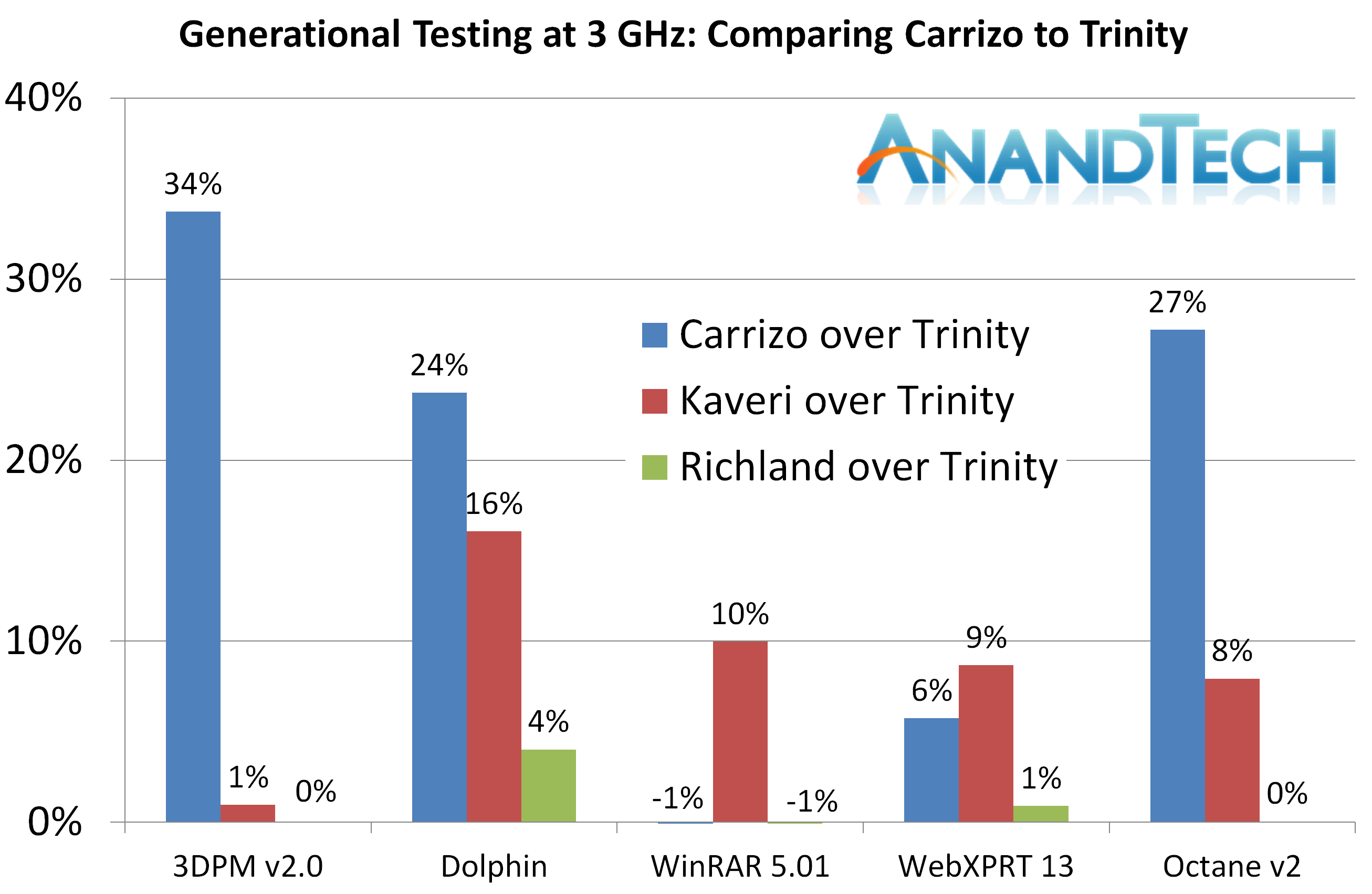
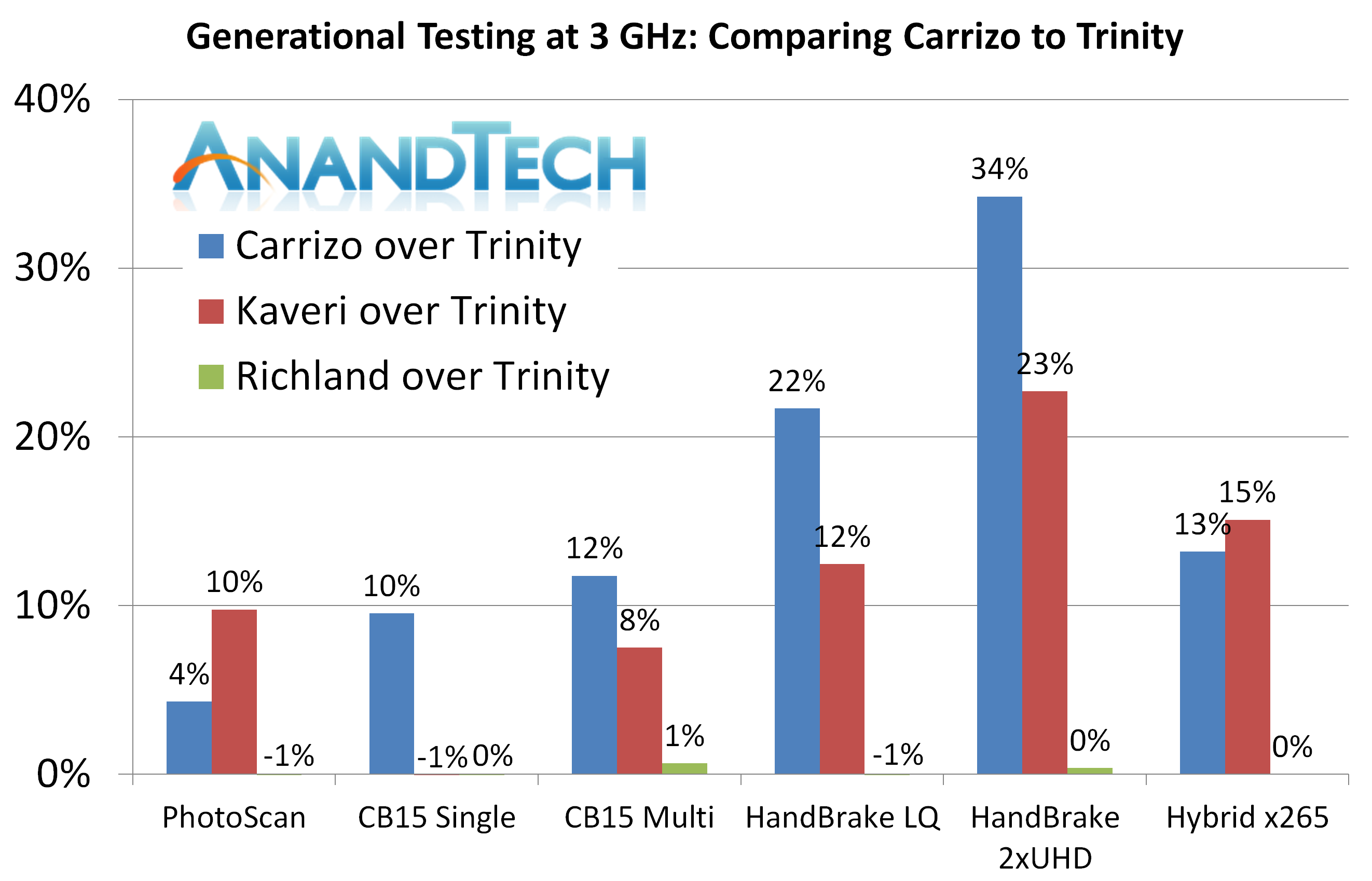
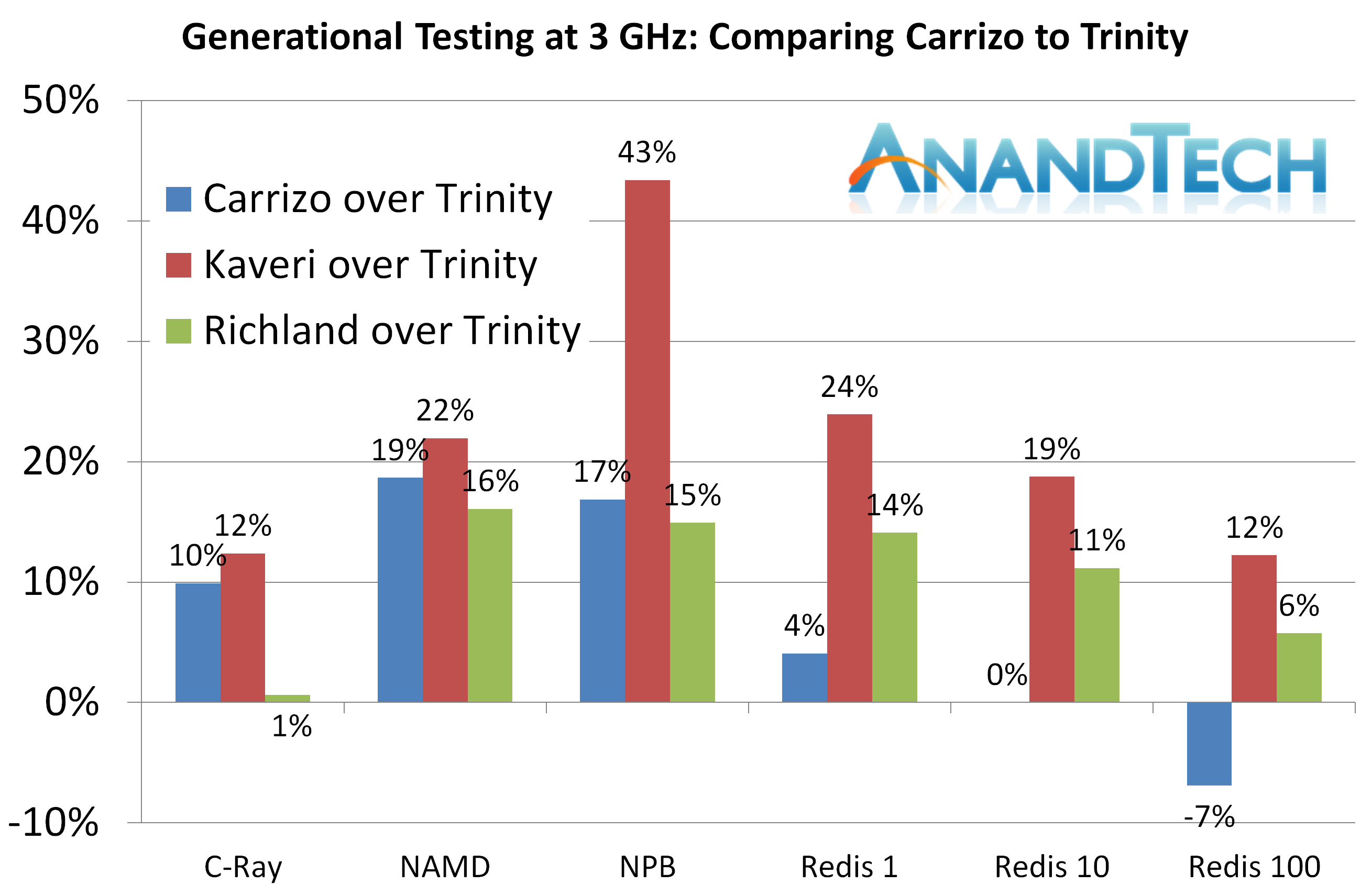
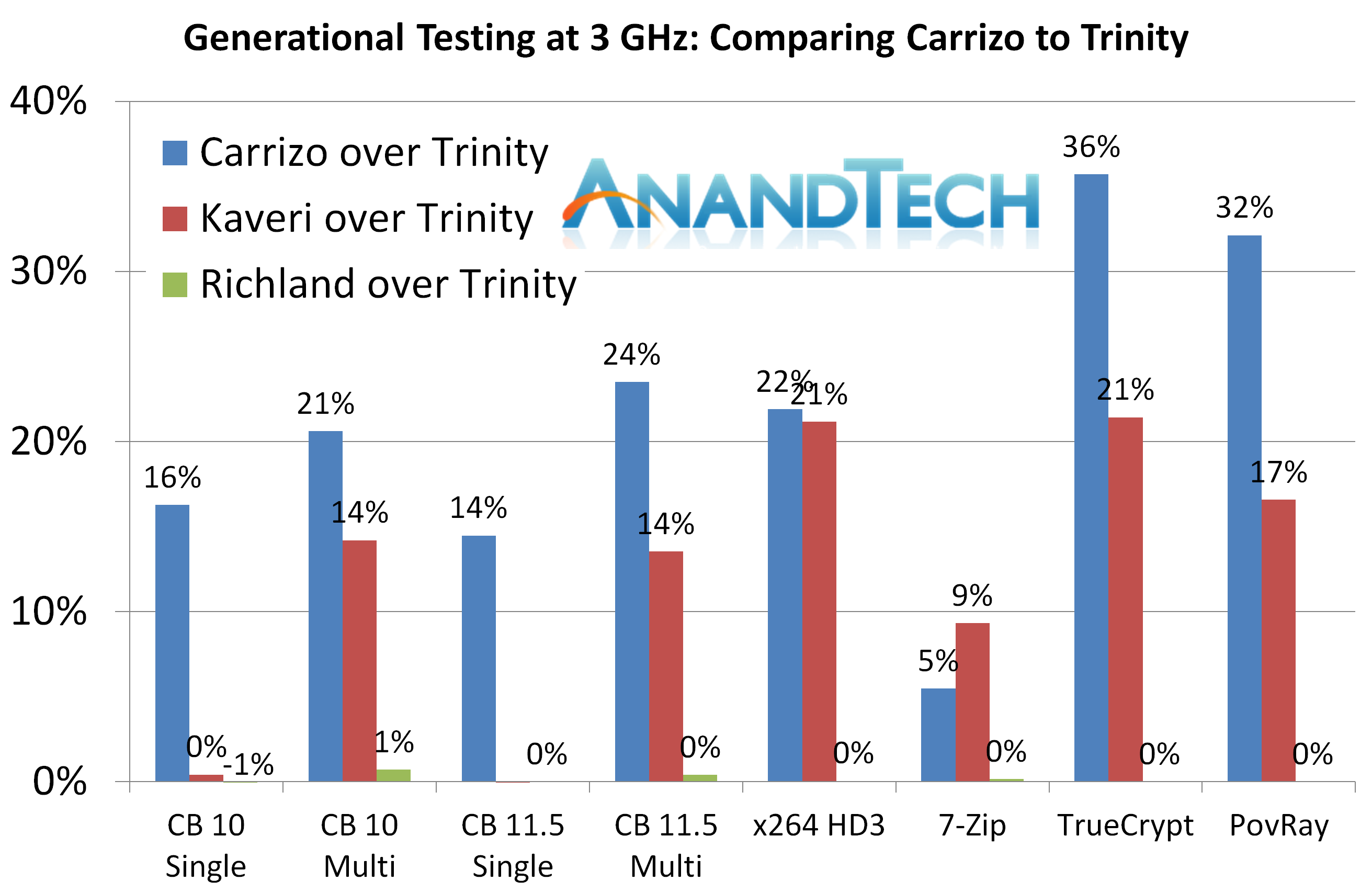

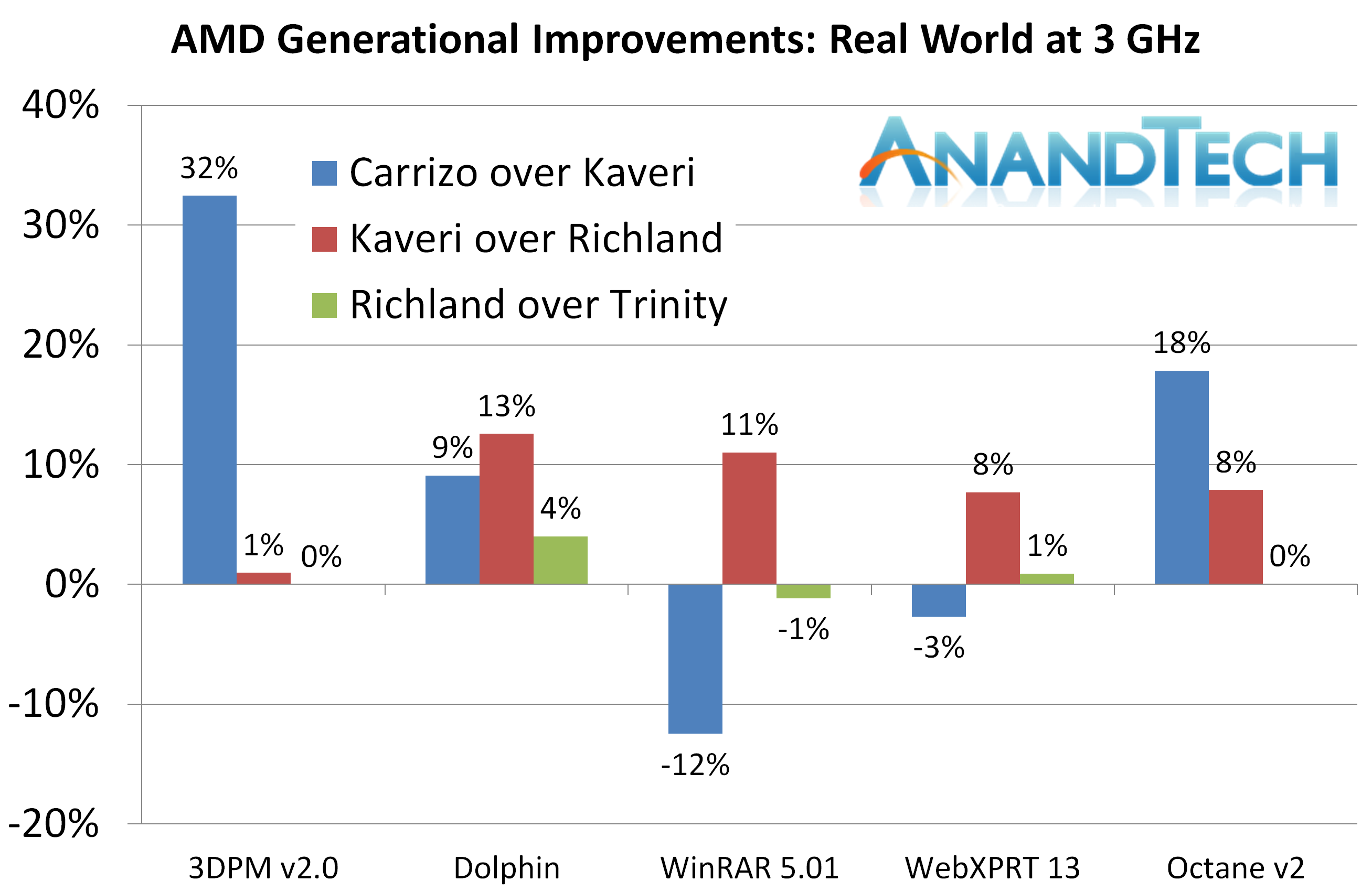


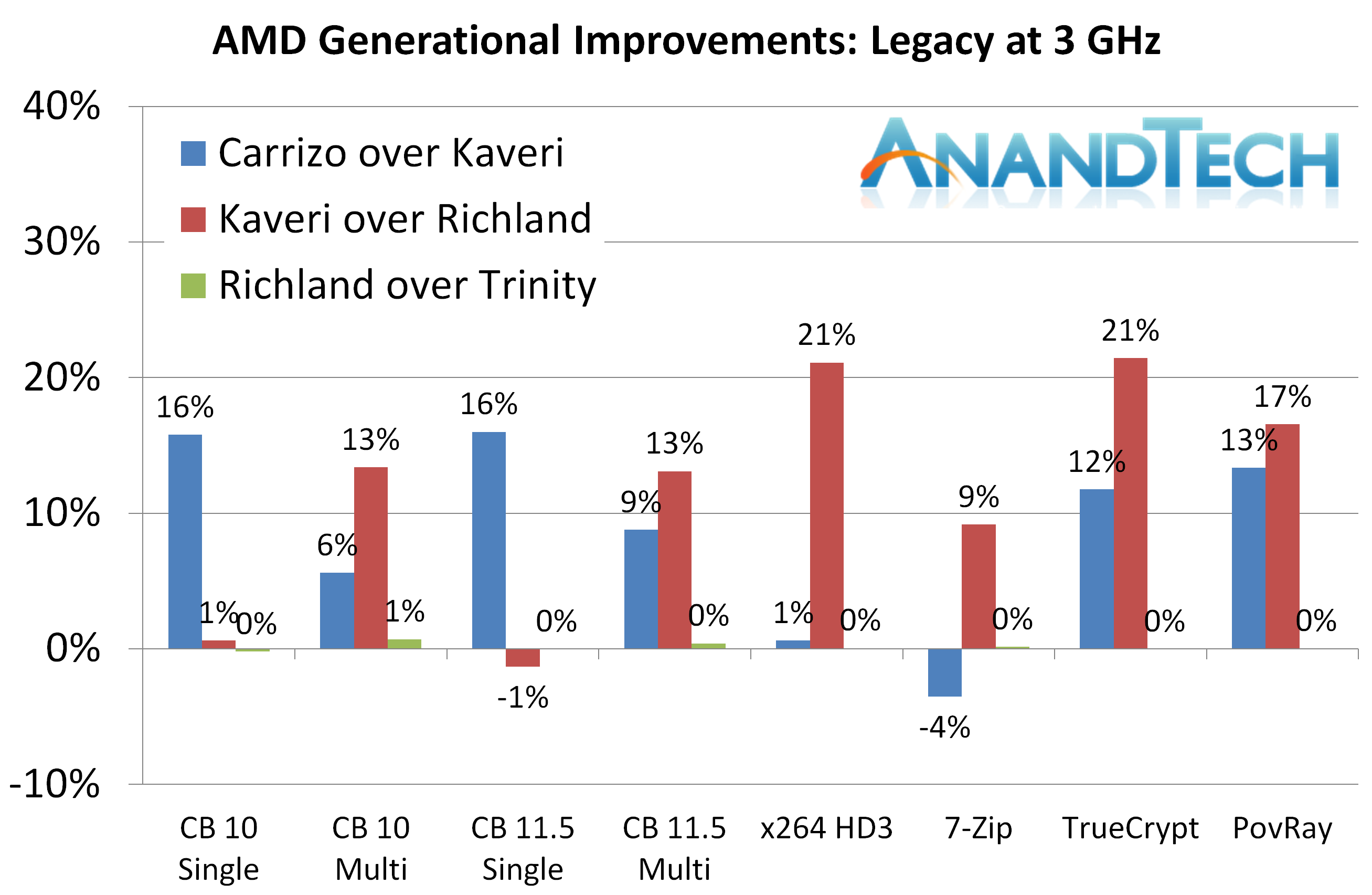
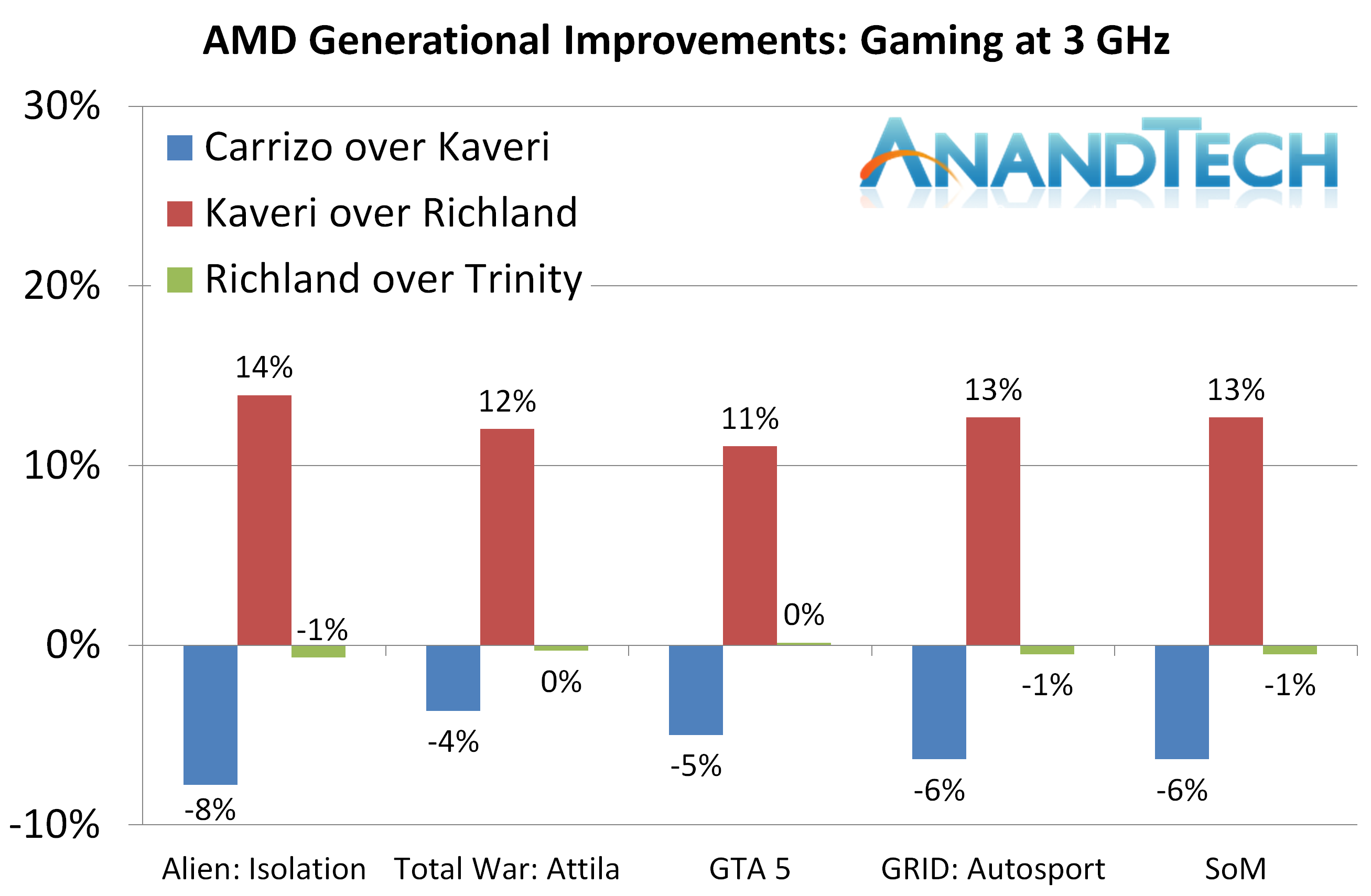








131 Comments
View All Comments
Meteor2 - Saturday, July 16, 2016 - link
Thanks. It's a little more complex than i3/5/7-nxxx, where n increments by one each generation...TheinsanegamerN - Monday, July 18, 2016 - link
cariizo cores use the excavator design. excavator is core design, carrizo is the product line.Mokona512 - Saturday, July 16, 2016 - link
Please do this test with the Phenom II series in order to understand the generational IPC changes, and also providing a better point of reference for the Zen CPUs. The Zen claims are based on IPC changes from a CPU series where there was a drop in IPC.Ian Cutress - Monday, July 18, 2016 - link
I recently redid a Phenom X6 in Bench, though that's absolute chip perf and not exactly what you're looking for, but it's there :)Elizabeth king - Sunday, July 17, 2016 - link
Love spell came out tremendously, I highly recommending robinson.buckler @ yahoo . com for whatever problems you are experiencing in your relationship. He is the real deal. his love spell is absolutely wonderful.lwatcdr - Sunday, July 17, 2016 - link
I find AMDs low cost offerings really interesting but this just doesn't work for me. The Carrizo on the desktop just seems too limiting. I wish that AMD would update the AM1 line. It is so inexpensive and can support a good number of PCIe lots. For things like a NAS, media pc, or even a Chrome box/low end pc they seem like a really good choice except that they have not been updated in years.silverblue - Monday, July 18, 2016 - link
Puma+ is kind of like what Atom did with their earlier Atoms, a more efficient version of Jaguar. I'm surprised that they didn't just lock the turbo and produce these in Jaguar's place, unless it's not cost-effective to do so.The cat cores are dead now, which is a shame as we never got to see how a dual channel memory interface would improve their performance.
Eris_Floralia - Monday, July 18, 2016 - link
Another great review. I've translated all articles about Bulldozer architecture into Chinese in order to let people know why it didn't success. I believe that an eight-core Steamroller or Excavator would be competitive, but that never comes out.TheinsanegamerN - Monday, July 18, 2016 - link
it wont be competitive, excavator is still far behind intel is performance and in TDP, and cant overclock at all. And it is still 28nm and cache limited.AMD really needs to kill the bulldozer line. It is AMD's netburst.
Eris_Floralia - Monday, July 18, 2016 - link
well, with some adjustments, steamroller can still reach high frequency. with additional L3 and larger L2, the problem with excavator may get solved. I mean that latest bulldozer architecture can do better than present piledriver, but the improvement obiviously doesnt worth a try.